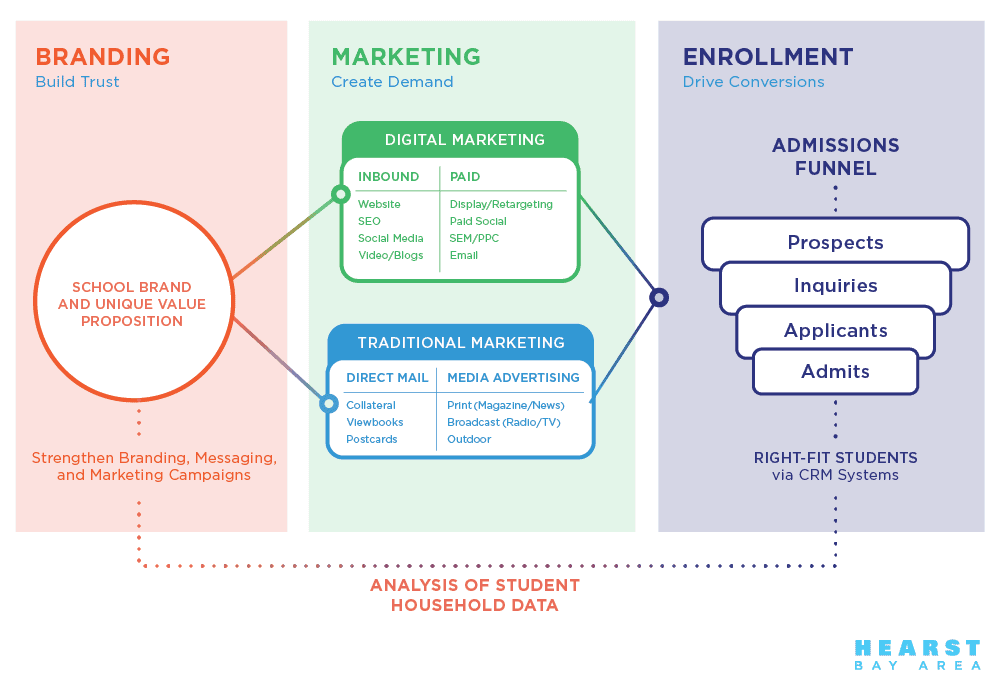In a normal situation, every student that seems like a good fit for your school would apply. But as a result of the tight competition and availability of information regarding private schools, it is difficult nowadays to even make students aware of your school.
Also, very few of those that have heard about your school would end up applying. So how then do you increase awareness of your school while also increasing enrollment?
Building a suitable marketing strategy around your enrollment funnel is the right bet.
But first, you have to understand what the enrollment funnel is, and the stages involved in it.
What is an Enrollment Funnel?

For those in the line of business, you might have heard ‘sales funnel’. Sales funnel is referred to the journey that a prospective customer passes through right from the time of awareness till when they make a purchase of a product. The same procedure is applied to the enrollment funnel of school – this is divided into three parts: Brand Awareness, Interest, and Enrollment.
Let us take a look at how this funnel works, and how you can create marketing strategies for each of the stages.
Brand Awareness
This stage works hand-in-hand with the reputation of your school. Most of the time, prospective parents tend to hear about your school from relatives, friends, and other third-party online platforms such as SchoolsCompass. It is only when your school is credible, that is when you can get referrals. The first stage is working on your brand, which is your school.
When people hear about your school, what do they say? What is your school known for? There are certain things that most schools are known for, you also want to ensure that your target audience recognizes you with these things you are known for.
It is also possible that some of your target audience does not have any prior knowledge about your school and only became informed during their research process. It is in situations like this that your marketing methods (like website and social media) should be able to answer some questions.
Interest
Your marketing strategies are greatly needed at this stage. Most parents develop interest after they might have done their research and have gotten the information they need. Establish two-way communication with prospective parents by using your marketing strategies to answer their questions. Share your information, tuition fee, academic offering, extra-curricular activities, club activities, social life, academic success rate, and the likes.
Enrollment
The ultimate goal of having marketing strategies is to increase enrollment. While many might have shown interest in your school, the number further reduces as they decide to apply. In the enrollment stage, there is also another mini-funnel called the admission funnel: Prospect → Inquiries → Applicants → Admits. Strategic messaging throughout each stage of this mini-funnel can further increase the chance of a student making your school their top choice.
Understanding Your Audiences and Their Journeys; Using persona mapping

There are two major decision-makers when it comes to choosing a school: the parents and the student. These comprise your audience and they are referred to as your marketing personas since they both have different reasons and experiences when looking for schools. Why are these two important? Well, you already know that – without students, no school. And without the parents, no one to pay the fees. This is why you have to understand their journeys.
Parents Journey
Parents are the ones paying the tuition fee, so they ensure that their research is about making the right investment for their kids and the family. Their first point of contact is google, they ask questions like which is the best option, private or public school. From there, they start to research specific schools by visiting their websites, checking out their facilities, and reading their reviews.
As parents, they compare things like prices, academic quality, reputation, and student outcomes. Once a parent has been able to narrow down to their top choice, they encourage the student to apply, or apply for such student.
Students Journey
Unlike the parents, students are most likely to focus on the fun and social part of a school. Students look for a learning environment where they can just fit right in and enjoy life outside of the classroom through extra-curricular activities and sports. To start, they ask their friends the schools they are attending, check their profiles out on social media to have a better insight into what their social life is like.
As you can see, these two have their ways of researching for schools, even though a student does not have a final say, they often times have some percentage of say in which school they attend. As a school, these are the elements you should lay emphasis on in your marketing strategies during the interest and decision-making stages of the parents’ and students’ enrollment journey.
